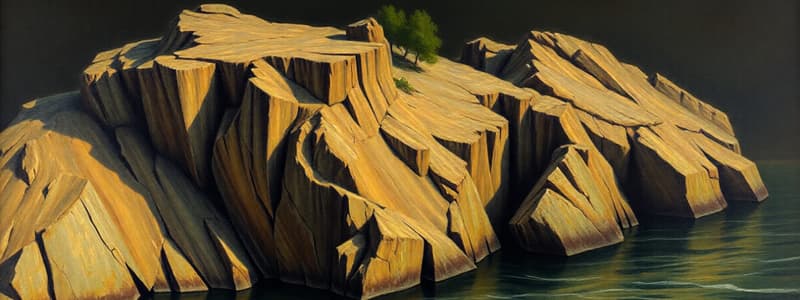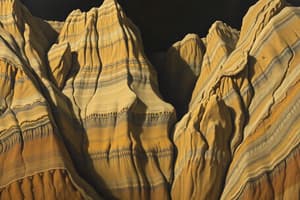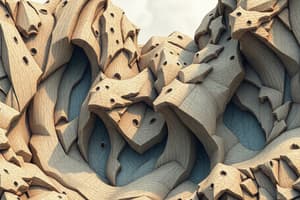Podcast
Questions and Answers
What do drainage divides do?
What do drainage divides do?
- Collect water from multiple rivers
- Act as a source of runoff
- Separate different drainage basins (correct)
- Provide a boundary for a river system
Which flow type describes water moving in parallel layers without mixing?
Which flow type describes water moving in parallel layers without mixing?
- Turbulent flow
- Laminar flow (correct)
- Surface runoff
- Glacial flow
What is the smallest type of stream that does not have tributaries?
What is the smallest type of stream that does not have tributaries?
- Third-order stream
- First-order stream (correct)
- Headwater stream
- Second-order stream
What is an example of a large drainage basin system?
What is an example of a large drainage basin system?
What influences streamflow?
What influences streamflow?
Which type of flow is commonly associated with white-water rafting?
Which type of flow is commonly associated with white-water rafting?
What geological structure is characterized by arches with older rocks at the center?
What geological structure is characterized by arches with older rocks at the center?
Which type of fault occurs when the hanging wall moves down relative to the footwall?
Which type of fault occurs when the hanging wall moves down relative to the footwall?
What type of stress is responsible for the formation of reverse faults?
What type of stress is responsible for the formation of reverse faults?
Which classification refers to the shape of folds that are neither symmetric nor symmetric?
Which classification refers to the shape of folds that are neither symmetric nor symmetric?
What is formed when two anticlines or synclines connect?
What is formed when two anticlines or synclines connect?
What type of boundary typically produces strike-slip faults?
What type of boundary typically produces strike-slip faults?
Which of the following accurately describes a syncline?
Which of the following accurately describes a syncline?
What process is referred to as orogeny?
What process is referred to as orogeny?
Which class of folds is identified by their tightness, axial plane orientation, and bed thickness?
Which class of folds is identified by their tightness, axial plane orientation, and bed thickness?
What is the most common type of mountain formed at the boundary of two continental tectonic plates?
What is the most common type of mountain formed at the boundary of two continental tectonic plates?
Which one of the following processes contributes to the evaporation segment of the water cycle?
Which one of the following processes contributes to the evaporation segment of the water cycle?
In which type of mountain formation does magma cool before being extruded?
In which type of mountain formation does magma cool before being extruded?
What percentage of Earth's water is freshwater?
What percentage of Earth's water is freshwater?
Which of the following processes is NOT part of the water cycle?
Which of the following processes is NOT part of the water cycle?
What is the role of runoff in the water cycle?
What is the role of runoff in the water cycle?
What is the process called when water changes from a solid to a gas?
What is the process called when water changes from a solid to a gas?
What is the main difference between infiltration and runoff?
What is the main difference between infiltration and runoff?
What phenomenon occurs when one tectonic plate sinks below another?
What phenomenon occurs when one tectonic plate sinks below another?
What is the primary composition of freshwater on Earth?
What is the primary composition of freshwater on Earth?
Flashcards
Anticlines
Anticlines
Folds in rock layers with older rocks at the center.
Synclines
Synclines
Folds in rock layers that are concave up, with older rocks on the outside.
Normal Fault
Normal Fault
Fault where the hanging wall moves down relative to the footwall.
Reverse Fault
Reverse Fault
Signup and view all the flashcards
Hanging Wall
Hanging Wall
Signup and view all the flashcards
Footwall
Footwall
Signup and view all the flashcards
Tectonic Plate
Tectonic Plate
Signup and view all the flashcards
Orogeny
Orogeny
Signup and view all the flashcards
Fault
Fault
Signup and view all the flashcards
Drainage Basin
Drainage Basin
Signup and view all the flashcards
Drainage Divide
Drainage Divide
Signup and view all the flashcards
What makes a river system grow?
What makes a river system grow?
Signup and view all the flashcards
Laminar Flow
Laminar Flow
Signup and view all the flashcards
Turbulent Flow
Turbulent Flow
Signup and view all the flashcards
Why is laminar flow important in stream ecology?
Why is laminar flow important in stream ecology?
Signup and view all the flashcards
Fold Mountains
Fold Mountains
Signup and view all the flashcards
Dome Mountains
Dome Mountains
Signup and view all the flashcards
Subduction Mountains
Subduction Mountains
Signup and view all the flashcards
Hot Spot Mountains
Hot Spot Mountains
Signup and view all the flashcards
Oceanic-Oceanic Plate Collision
Oceanic-Oceanic Plate Collision
Signup and view all the flashcards
Evaporation
Evaporation
Signup and view all the flashcards
Condensation
Condensation
Signup and view all the flashcards
Precipitation
Precipitation
Signup and view all the flashcards
Transpiration
Transpiration
Signup and view all the flashcards
Runoff
Runoff
Signup and view all the flashcards
Study Notes
Geological Features: Folds
- Folds are rock layers compressed by stress.
- Three main linear fold types:
- Anticlines: arched, older rocks at center.
- Synclines: concave up, older rocks on the outside.
- Monoclines: one prominent dipping slope.
- If rock age is unknown or reversed, use antiforms/synforms instead of anticlines/synclines.
- Further fold classifications: asymmetric, symmetric, overturned, recumbent, isoclinal, Chevron, parasitic, ptygmatic, disharmonic.
- Domes and basins formed by connecting anticlines/synclines.
- Plunging anticlines/synclines have tilted hinge lines.
- Folds identified by tightness, axial plane orientation, and bed thickness.
Plate Tectonics and Faults
- Earth's crust composed of tectonic plates.
- Plate boundaries where plates meet.
- Faults are fractures in the crust along plate boundaries.
- Two sides of a fault:
- Hanging wall: above the fault.
- Footwall: below the fault.
- Normal faults: hanging wall moves down.
- Reverse faults: hanging wall moves up.
- Three types of stress causing faults:
- Compressional: pushes blocks together (reverse).
- Shear: blocks slide past (strike-slip).
- Tensional: pulls blocks apart (normal).
Mountain Formation (Orogeny)
- Mountains are high-altitude geologic features.
- Made of rock formed from minerals.
- Fold mountains form from colliding continental plates.
- Dome mountains form from magma rising and cooling.
- Subduction (one plate sinking under another) creates mountain ranges.
- Hotspot mountains form from magma rising at fixed points (e.g., Hawaii).
- About 40-50 global hotspot locations. Not all islands are hotspot mountains.
- Oceanic plate collisions can also create mountains.
The Water Cycle
- Recycles freshwater on Earth.
- Main parts: evaporation, condensation, precipitation.
- Water changes phases (liquid, solid, gas).
- Processes in order: evaporation, condensation, precipitation, sublimation, transpiration, runoff, infiltration.
- Water enters atmosphere through evaporation, sublimation, transpiration.
- Condensation forms clouds, leading to precipitation (rain, snow, sleet, hail).
- Runoff carries water to rivers and eventually groundwater.
Water Distribution and Importance
- 97% of Earth's water is salty.
- Only 3% is freshwater, mostly locked in glaciers/ice.
- 30% of freshwater is underground, very important to humans.
- Less than 1% of the world's water is readily available (surface).
- Still a vast amount of freshwater is available, however, the accessible amount is limited.
Water Cycle Processes: Evapotranspiration, Condensation, Precipitation
- Water cycles around the planet.
- Evapotranspiration: evaporation from surfaces + transpiration from plants.
- Evaporation rates increase with sunlight, dryness, wind, heat.
- Transpiration occurs through plant stomata.
- Water condenses into clouds.
- Precipitation (rain, snow, sleet) returns water to the surface.
Runoff and Infiltration
- Runoff: water flowing across the land surface.
- Infiltration: water seeping into the soil.
- Runoff occurs on non-porous surfaces or saturated ground.
- Runoff collects in ravines, gullies, etc., heading to larger water bodies.
- Runoff can erode land, harming ecosystems.
- Infiltration rate depends on soil permeability, slope, and vegetation.
Drainage Basins and River Systems
- Drainage basin (watershed): area where water drains into a common outlet (river).
- Drainage basins vary in size.
- Drainage divides (high ground) separate basins.
- River systems begin as small streams (first-order), merge into larger streams.
Streamflow: Laminar and Turbulent
- Streamflow: water movement in a stream channel.
- Laminar flow: smooth, parallel layers, slow velocity.
- Turbulent flow: random flow, fast velocity due to obstacles.
Studying That Suits You
Use AI to generate personalized quizzes and flashcards to suit your learning preferences.
Description
Explore the fascinating world of geological folds and faults. This quiz covers the definitions, classifications, and characteristics of various fold types and their relationship with plate tectonics. Test your knowledge on structures like anticlines, synclines, and the mechanics of faults.




